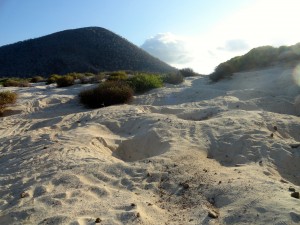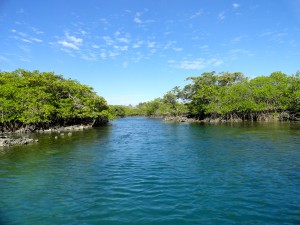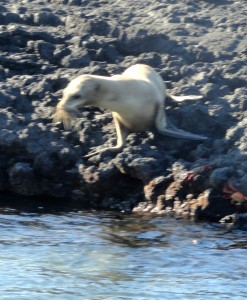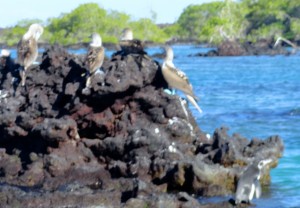Unlike their cousins, the Emperor Penguins of Antarctica, Galapagos Penguins are petite creatures weighing five pounds or less. What they lack in impressive stature, they make up for in what I call the “cuddly factor.” I first saw them traveling along the coastline of Bartolome Island in a zodiac. Oblivious to gawking tourists, two couples continued to mate.

Galapagos penguins go after small fish, like mullet or sardines. In the water, the penguins are vulnerable to sharks and Galapagos fur seals. Land predators include the Galapagos hawk. Feral cats are also a large problem, and are actively pursued by the Galapagos National Park. But the biggest threat to Galapagos penguins is El Niño years when the Peru Current warms up, reducing the amount of plankton to support small fish. The El Niño events of 1982-83 and 1997-98 resulted in sharp declines in the penguin population.

The Galapagos green sea turtle is the only subpopulation of green sea turtles to have a separate species classification. Weighing up to two hundred pounds, the Galapagos green sea turtle is smaller than other green sea turtles. They can swim long distances in a short amount of time, and have been clocked swimming at a pace of thirty-five miles per hour.
Factoid: Sea turtles shed large tears from salt glands behind their eyes. The glands clear sea salt from the turtle’s system.

Green sea turtle females mate with several males, a tiring activity which brings them to the surf line to rest.

When she’s ready to lay her eggs, the female emerges from the sea about sunset, drags herself above the high water line, and digs three pits in the sand. In one of them, the turtle lays about seventy-five eggs. In an effort to confuse predators, the turtle covers all the pits. She finally heads back to sea at around sunrise. This process can happen up to eight times in a single breeding season. The pits seen in this nesting area are not the nests, but happen when the female covers over her nest. Once the eggs are laid, turtle moms are done.
Baby turtles are vulnerable from the moment they emerge. If they are fortunate and make their way to the surface under cover of darkness, survival chances are better. But if the hatchlings misjudge and appear during the day, frigate birds swoop down for a meal.

The mangrove plants in the Galapagos Islands are thought to have originated in the Far East and floated across the oceans for millions of years before making landfall on the Galapagos Islands. Here they adapted to grow in muddy saltwater and brackish water.

Cruising into the mangrove forest aboard a zodiac, I remembered a ride at Disneyland called the Jungle Cruise. At a certain point, the boat went around a bend, the “guide” grabbed a rifle and shot whatever the mechanical being was. Only, this was real life and nothing jumped up out of the water, which was fine with me.



As we left the mangrove area to return to the ship, we passed a set of rocks where a number of creatures were sunning themselves. Penguins, blue-footed boobies, and sea lions watched us glide by.



This is the last blog entry on my visit to the Galapagos Islands. I hope you’ve enjoyed the series. Darned if I know what we’ll talk about next week.
Acknowledgements:
Featured Image: Galapagos Penguins
Photos by Author. All Rights Reserved.
John P Rafferty. “Galapagos Penguin.” Encyclopedia Britannica. Here.
Victor Carrion. “Control and Eradication of Feral Cats.” Here.
“Galapagos Green Turtle.” Galapagos Islands Tour Guide. Here.

Sandra Wagner-Wright holds the doctoral degree in history and taught women’s and global history at the University of Hawai`i. Sandra travels for her research, most recently to Salem, Massachusetts, the setting of her new Salem Stories series. She also enjoys traveling for new experiences. Recent trips include Antarctica and a river cruise on the Rhine from Amsterdam to Basel.
Sandra particularly likes writing about strong women who make a difference. She lives in Hilo, Hawai`i with her family and writes a blog relating to history, travel, and the idiosyncrasies of life.


Thank you, thank you…..very interesting. Guess I will never get there during my life time. You Blog sure helped for me to see what Galapagos is all about….Wonderful pictures!!! xoxoxodk